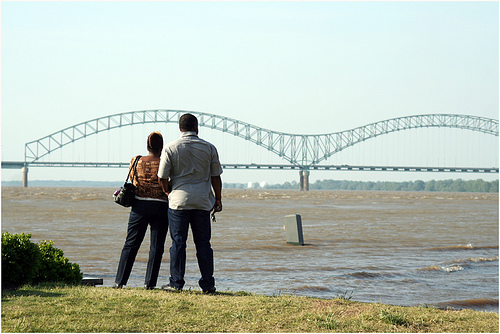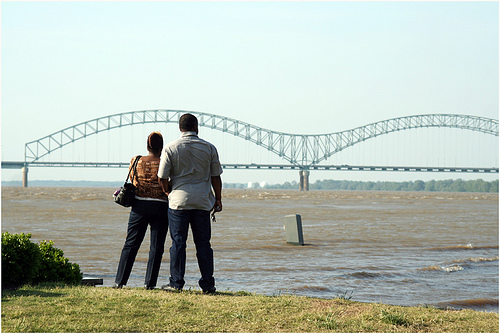 The Mississippi River flooding part of downtown Memphis.Photo: Chris WielandThe Mississippi River is experiencing its second “500-year flood” since 1993. That’s no freak occurrence — scientists say it’s a result of human-made carbon pollution changing our climate.
The Mississippi River flooding part of downtown Memphis.Photo: Chris WielandThe Mississippi River is experiencing its second “500-year flood” since 1993. That’s no freak occurrence — scientists say it’s a result of human-made carbon pollution changing our climate.
“All extreme weather events are now subject to human influence,” said Peter Gleick, a climate and water scientist and the president of the Pacific Institute, at a Capitol Hill briefing on Monday organized by the American Meteorological Society (AMS). “We are loading the dice and painting higher numbers on them.”
Forecasters expected the Mississippi River to top out in Memphis on Monday night just inches below the record level:
The Mississippi River, the largest U.S. river system, is forecast to crest today in Memphis, Tennessee, just below its 74-year-old record, as a bulge of water moves south toward the riverside refineries in Louisiana.
The river is forecast to reach 48 feet in Memphis at 7 p.m., compared with the old mark of 48.7 feet, according to a revised National Weather Service forecast. …
The Mississippi threatens 3,075 buildings, including 949 homes and 12 apartment complexes, in Tennessee’s Shelby County, which includes Memphis, the Memphis/Shelby County Emergency Management Agency said yesterday. Exxon Mobil Corp. shut its Memphis fuel terminal on April 29, Kevin Allexon, a company spokesman, said in an e-mail.
Flooding like the Mississippi River is seeing in 2011 used to be considered extremely unusual. But thanks to the climate crisis, floods are becoming more frequent and more severe over much of the Mississippi River basin — so much so that the old way of measuring things is tragically outdated:
Problems with the [U.S. Army Corps of Engineers] probabilities are exemplified by recent flooding at Hannibal, Missouri. The record stage set in 1993 exceeded the calculated 500-year level, whereas 2008 was a 200-year event. In addition, 2001 suffered a 50- to 100-year flood, 1986 and 1996 experienced 25- to 50-year floods, and five more years had 10-to 25-year floods. Are these calculated recurrence intervals reasonable, or is it more likely that the dice, in effect, are loaded?
Dr. Gleick told the AMS briefing that increasing temperatures aren’t necessarily leading to more frequent rainfall events. But the climate crisis IS leading to more intense rainfall events. We’re seeing the same number of storms, but the ones we do see are more likely to be the kind that cause severe flooding.
As the Wall Street Journal reports, that’s pushing our flood control system to the breaking point:
The heavy strains on the system and concerns that floods are getting more frequent and damaging are sparking a re-examination of flood control. In years past, the call likely would have gone out for higher levees and more so-called gray infrastructure — concrete and cement structures to keep the Mississippi inside its banks. Now some flood experts, along with some states, are saying that trying to control the river won’t do the job.
What can we do instead? Take advantage of ecosystems that absorb water instead of deflecting it downstream:
A study by the state of Illinois found that fully exploiting the water-absorption capacity of one such tract near Peoria would reduce flooding in the city by a few inches and affect flood levels as many as 80 miles downstream, [the Nature Conservancy’s Michael] Reuter said.
Right now, Congress hasn’t shown a willingness to change our policies to reflect our losing battle with nature. Congress still hasn’t acted to restore coastal Louisiana wetlands, a critical buffer against global warming-fueled hurricanes. And misguided budget cutters have even gone so far as to slash funding for weather forecasting satellites — replacements for the aging satellites that saved lives by predicting this year’s Mississippi River floods.




